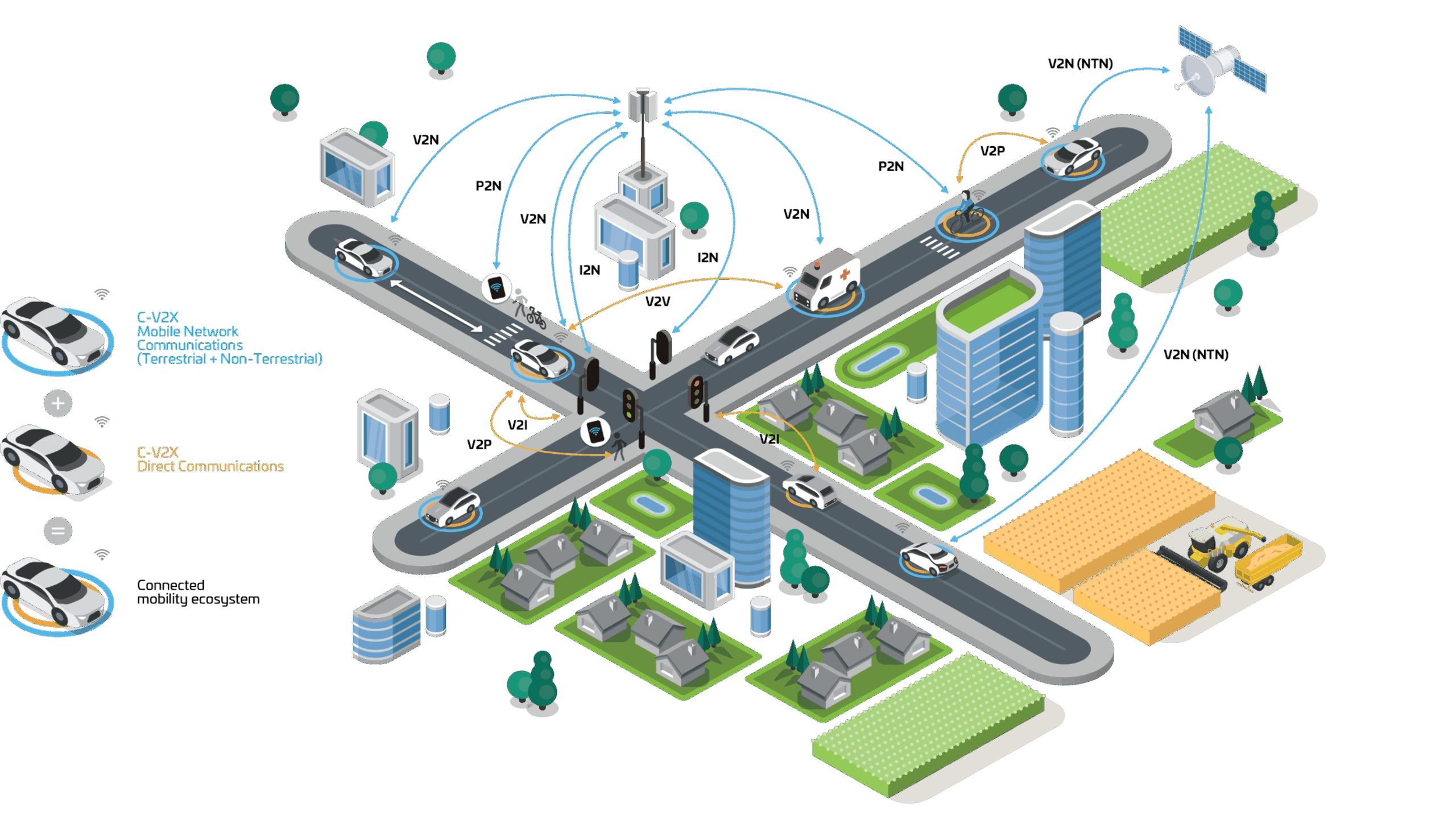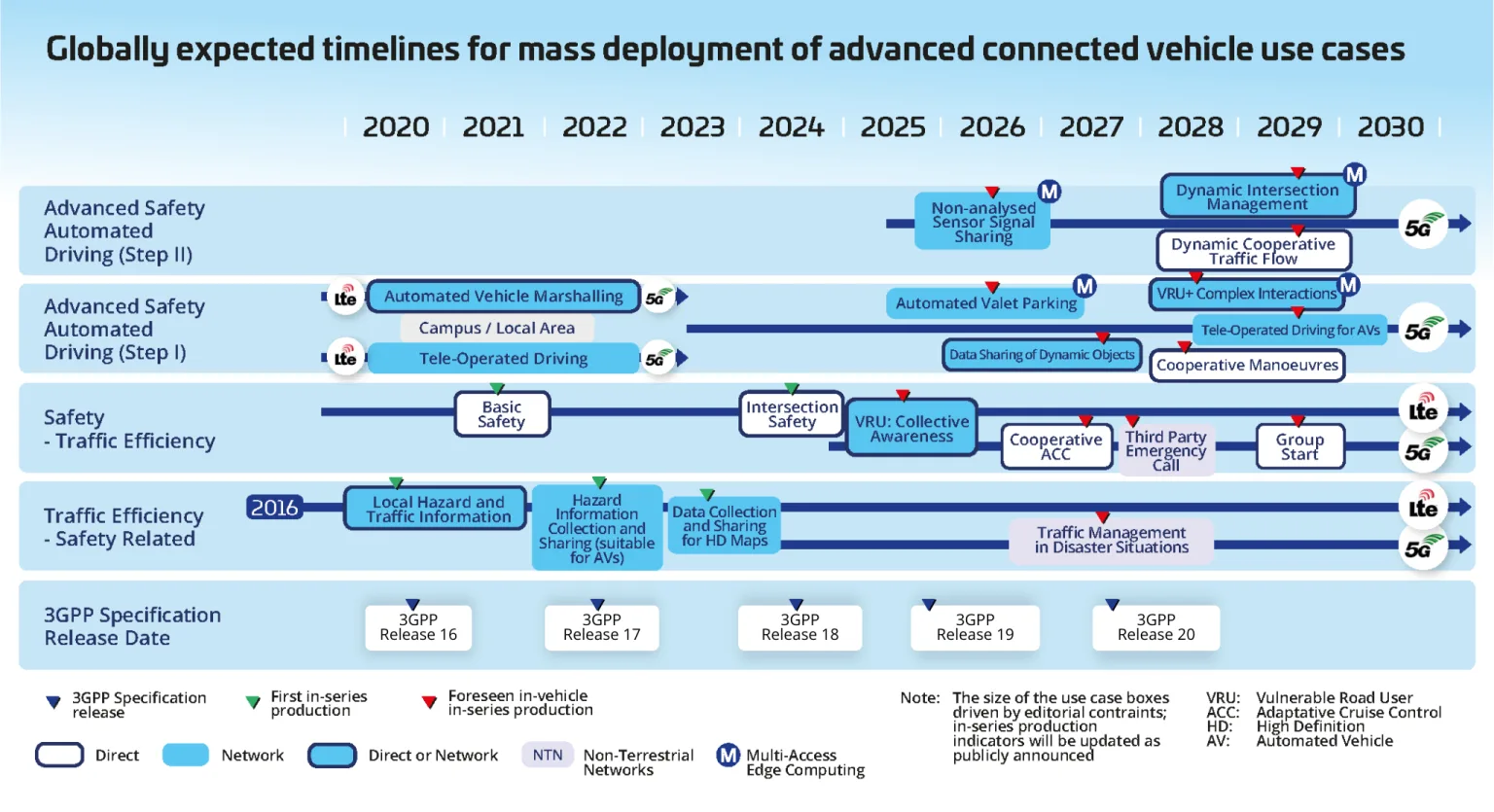The automotive industry is moving toward a future where vehicles don’t just transport passengers but actively communicate with each other and their surroundings. At the center of this shift is C-V2X Direct, a breakthrough in direct vehicle communication that eliminates the need for cellular networks when every millisecond counts.
C-V2X Direct, standardized by 3GPP and championed by the 5G Automotive Association (5GAA), is designed to enable ultra-low-latency, real-time communication between vehicles (V2V), infrastructure (V2I), and pedestrians or cyclists (V2P). With deployments already happening in Asia, North America, and Europe, this technology is set to become the foundation of global road safety.
At Horizon Connect, we help automotive OEMs and mobility providers adopt C-V2X Direct by integrating it seamlessly into broader IoT connectivity strategies. Our solutions ensure vehicles are globally connected, secure, and ready to meet the demands of modern mobility—anywhere, anytime.
What Is C-V2X Direct?
C-V2X stands for Cellular Vehicle-to-Everything, and it operates in two main modes:
- C-V2X Direct (PC5 interface):
This enables direct communication between vehicles, roadside units, and pedestrians’ devices—without going through a cellular network. It uses the 5.9 GHz ITS band for ultra-reliable, short-range messages that are crucial for safety. - C-V2X Network (Uu interface):
This mode relies on 4G/5G cellular networks for cloud-based services such as navigation, telematics, and over-the-air (OTA) updates.
The PC5 interface is what makes C-V2X Direct revolutionary. By bypassing cellular networks, it ensures that critical safety messages—like sudden braking alerts, pedestrian detection, or intersection collision warnings—are transmitted in under 20 milliseconds. This is significantly faster than human reaction time, and it works even in areas with poor network coverage.

How the PC5 Interface Works
The PC5 interface is a sidelink communication channel. Vehicles equipped with C-V2X Direct broadcast information up to 10 times per second, creating a real-time safety bubble around them.
Key technical aspects include:
- Autonomous Resource Allocation: Each vehicle senses available radio slots and transmits without network scheduling. This ensures reliability even in dense traffic.
- Global Spectrum Allocation: Many regions have already allocated the 5.9 GHz band for ITS safety, making C-V2X Direct viable globally.
- Always-On Capability: Messages are exchanged without requiring SIM cards, mobile coverage, or infrastructure support—ideal for emergency scenarios.
- Scalability for 5G NR-V2X: With future 5G releases, PC5 will support even more advanced use cases, including sensor sharing and cooperative driving maneuvers.
In essence, C-V2X Direct equips vehicles with instant situational awareness, which can mean the difference between a safe trip and a collision.
Why C-V2X Direct Matters for Road Safety
The real strength of C-V2X Direct lies in its ability to enable life-saving applications that were previously impossible or unreliable with legacy technologies like DSRC.
1. Collision Avoidance
Imagine two cars approaching an intersection at high speed. One driver fails to stop at a red light. With C-V2X Direct, both cars exchange trajectory data instantly, and the system warns the drivers—or intervenes automatically—to avoid a crash.
5GAA demonstrations have already shown how Emergency Electronic Brake Light (EEBL) warnings are transmitted in milliseconds, giving trailing cars the chance to react long before human reflexes would kick in.
2. Protecting Vulnerable Road Users (VRUs)
Cyclists and pedestrians are among the most at risk on busy roads. C-V2X Direct can connect their devices (such as smartphones or helmets) directly to nearby vehicles.
In one high-profile demo, Audi showcased how C-V2X Direct alerts drivers to hidden cyclists at intersections. Similarly, Autotalks tested VRU detection where a car automatically slowed after receiving an alert about a cyclist outside the driver’s field of view.
3. Emergency Vehicle Priority
Ambulances, fire trucks, and police vehicles often lose precious seconds navigating through traffic. With C-V2X Direct, they can broadcast their presence directly to surrounding cars, which automatically receive warnings and clear a path—even before lights and sirens are noticed.
5GAA’s Atlanta “Day One Deployment District” showcased how emergency vehicles could reliably pre-empt traffic signals and warn nearby cars, reducing response times dramatically.
4. Road Infrastructure Integration
Traffic signals and roadside sensors can also communicate via C-V2X Direct. Use cases include:
- Red Light Violation Warning (RLVW): Alerts drivers if they’re about to run a red light.
- Road Works Warning (RWW): Notifies vehicles of upcoming construction zones.
- Green Light Optimal Speed Advisory (GLOSA): Helps drivers adjust speed to catch a green wave.
These applications not only improve safety but also reduce congestion and emissions.
Global Deployment Roadmap of C-V2X Direct
C-V2X Direct is no longer a future vision—it is actively being deployed worldwide.
- China: Since 2020, multiple OEMs have launched C-V2X-equipped models. Over 90 cities and 5,000 km of smart roads support C-V2X with roadside units.
- Europe: EU projects like C-Roads and 5G corridors are preparing infrastructure. Mass deployment of C-V2X Direct is projected between 2026–2029, starting with major transport corridors.
- North America: In 2020, the FCC reserved 30 MHz of spectrum for C-V2X. By 2025, live deployment districts like Atlanta have already demonstrated real-world use cases.
By 2030, industry roadmaps predict hundreds of millions of vehicles globally will be equipped with C-V2X Direct, enabling a truly cooperative transport ecosystem.

Figure 2 – Roadmap of deployment of advanced connected vehicles use cases – (Source 5GAA)
Conclusion
C-V2X Direct is more than just another automotive technology—it’s a game-changer for global road safety. By enabling direct, ultra-low-latency communication between vehicles, infrastructure, and road users, it reduces accidents, enhances traffic efficiency, and paves the way for autonomous mobility.
With Horizon Connect’s global IoT expertise, automotive OEMs can confidently integrate C-V2X Direct into their vehicles, ensuring that every car is connected, compliant, and future-ready. The road ahead is cooperative, connected, and safer—and Horizon Connect is here to drive that future.


